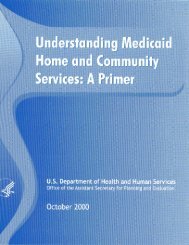physical activity fundamental to preventing disease - ASPE - U.S. ...
physical activity fundamental to preventing disease - ASPE - U.S. ...
physical activity fundamental to preventing disease - ASPE - U.S. ...
Create successful ePaper yourself
Turn your PDF publications into a flip-book with our unique Google optimized e-Paper software.
Physical Activity Fundamental <strong>to</strong> Preventing Disease<br />
Regular <strong>physical</strong> <strong>activity</strong>, fitness, and exercise are critically important for the health and well<br />
being of people of all ages. Research has demonstrated that virtually all individuals can benefit<br />
from regular <strong>physical</strong> <strong>activity</strong>, whether they participate in vigorous exercise or some type of<br />
moderate health-enhancing <strong>physical</strong> <strong>activity</strong>. Even among frail and very old adults, mobility and<br />
functioning can be improved through <strong>physical</strong> <strong>activity</strong>. 1 Therefore, <strong>physical</strong> fitness should be a<br />
priority for Americans of all ages.<br />
Regular <strong>physical</strong> <strong>activity</strong> has been shown <strong>to</strong> reduce the morbidity and mortality from many<br />
chronic <strong>disease</strong>s. Millions of Americans suffer from chronic illnesses that can be prevented or<br />
improved through regular <strong>physical</strong> <strong>activity</strong>:<br />
$ 12.6 million people have coronary heart <strong>disease</strong> 2 ;<br />
$ 1.1 million people suffer from a heart attack in a given year 2 ;<br />
$ 17 million people have diabetes; about 90% <strong>to</strong> 95% of cases are type 2 diabetes, which is<br />
associated with obesity and <strong>physical</strong> in<strong>activity</strong> 3 ; approximately 16 million people have >pre<br />
diabetes=;<br />
$ 107,000 people are newly diagnosed with colon cancer each year 4,5 ;<br />
$ 300,000 people suffer from hip fractures each year 6 ;<br />
$ 50 million people have high blood pressure 2 ; and<br />
$ Nearly 50 million adults (between the ages of 20 and 74), or 27% of the adult population,<br />
are obese; overall more than 108 million adults, or 61% of the adult population are either<br />
obese or overweight. 7,8<br />
In a 1993 study, 14 percent of all deaths in the United States were attributed <strong>to</strong> <strong>activity</strong> patterns<br />
and diet. 9 Another study linked sedentary lifestyles <strong>to</strong> 23 percent of deaths from major chronic<br />
<strong>disease</strong>s. 10 For example, <strong>physical</strong> <strong>activity</strong> has been shown <strong>to</strong> reduce the risk of developing or<br />
dying from heart <strong>disease</strong>, diabetes, colon cancer, and high blood pressure. On average, people<br />
who are <strong>physical</strong>ly active outlive those who are inactive. 11-16<br />
Despite the well-known benefits of <strong>physical</strong> <strong>activity</strong>, most adults and many children lead a<br />
relatively sedentary lifestyle and are not active enough <strong>to</strong> achieve these health benefits. A<br />
sedentary lifestyle is defined as engaging in no leisure-time <strong>physical</strong> <strong>activity</strong> (exercises, sports,<br />
<strong>physical</strong>ly active hobbies) in a two-week period. Data from the National Health Interview Survey<br />
shows that in 1997-98 nearly four in 10 (38.3 percent) adults reported no participation in leisuretime<br />
<strong>physical</strong> <strong>activity</strong>. 17<br />
2
















